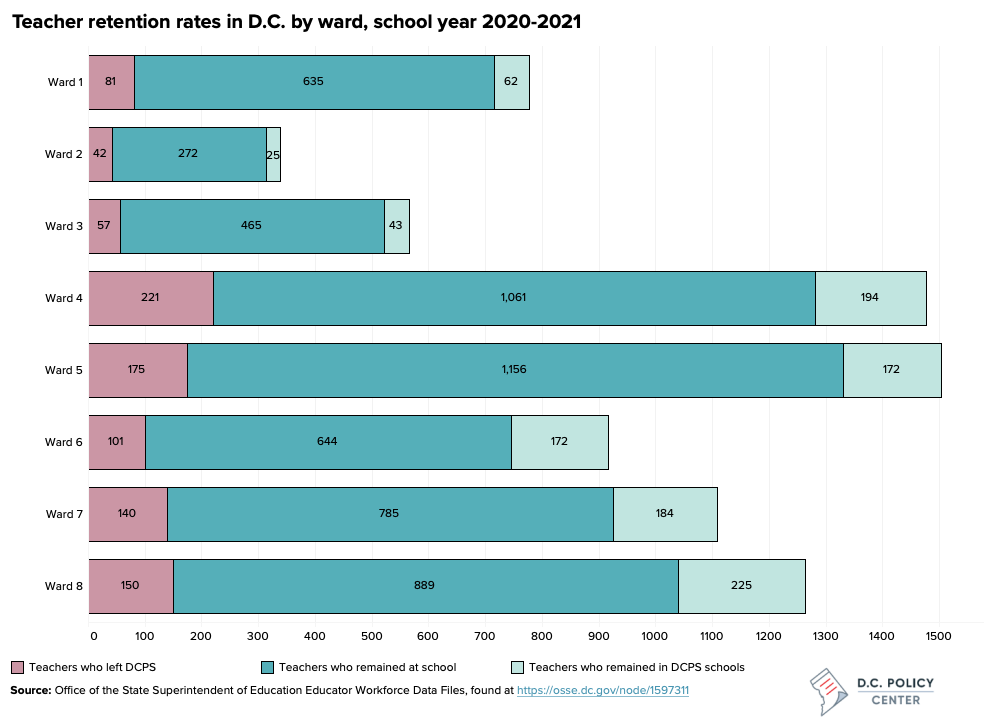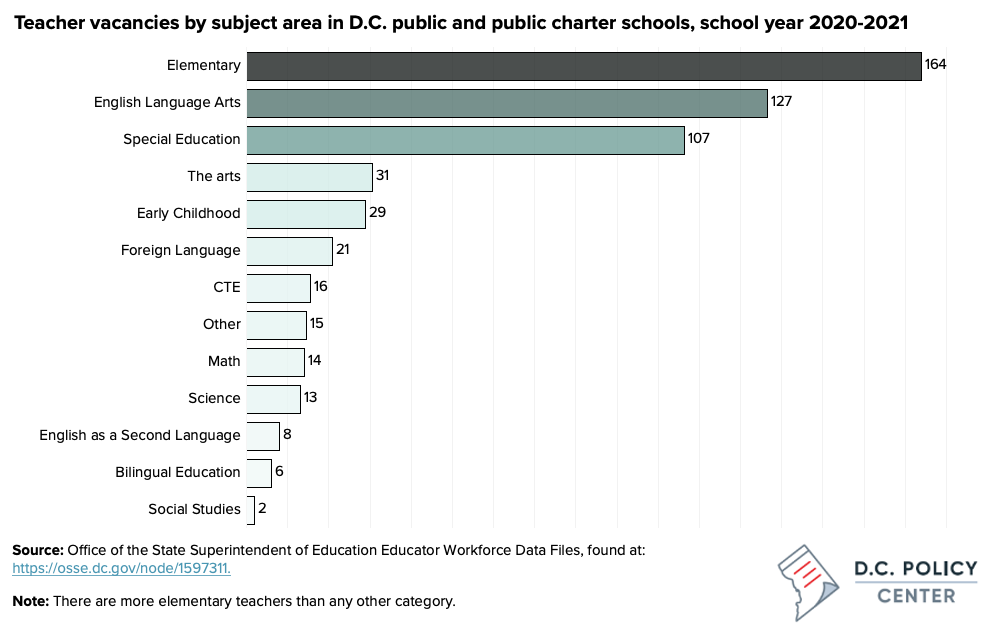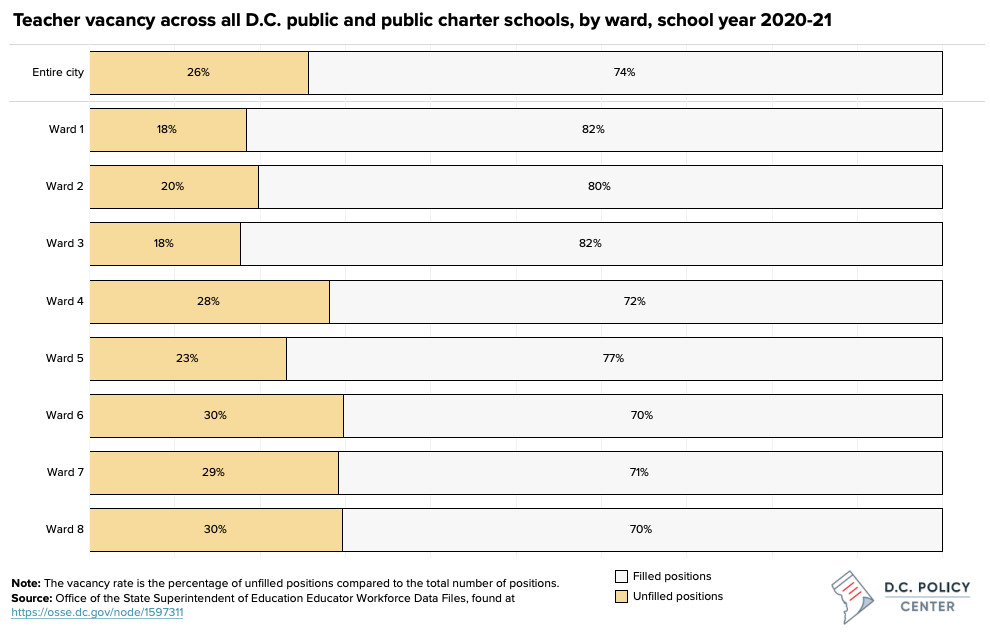Teacher shortages nationwide have impacted the schools’ ability to function and their full potential. When school districts do not have enough teachers, schools cannot meet student needs, and existing teachers often end up pressed into service to fill employment gaps. School districts are struggling to fill teacher vacancies and are searching for effective methods to recruit and keep teachers.
In the 2021-2022 school year, D.C. public and public charter schools retained an average of 74 percent of their teachers, compared to a national average of 84 percent. However, some areas of D.C. have faced lower teacher retention than others, with greater shares of teachers in Wards 6, 7, and 8 choosing to leave their schools.
School districts in the D.C. area have faced sharp increases in teacher resignations in the last few years. D.C.’s resignations increased by 52 percent, but in some nearby districts like Arlington Public Schools resignations increased by 96 percent. Additionally, D.C. has faced pronounced shortages in elementary, special education, and English Language Arts (ELA) teachers.




Typically, conversations around retaining and recruiting teachers center around financial incentives as a key way to keep teachers. However, research shows that while financial incentives can help keep and attract teachers, they are just one small element in a much larger set of factors that may keep teachers.
A study from the D.C. State Board of Education (SBOE) found a few key reasons teachers left schools. They are ranked in order of importance to teachers:
- Lack of professional support from administration to address challenges
- Lack of respect from school and/or LEA administration
- General workload too great/overburdened
- Dislike reliance on teacher evaluation systems
- Not enough resources for discipline/behavioral issues with students
- Unappreciated/successes unrecognized.
Strategies for attracting and retaining teachers
There are many strategies that school districts have employed to address reasons teachers are leaving, help improve teacher working conditions and ensure they attract and keep teachers. A few of these include flexible scheduling, administrator training, growth-based evaluation systems, and residency programs.
Flexible scheduling allows teachers to design a schedule with more flexibility around their working hours. For instance, roughly 1,600 of 13,452 school districts in the U.S. have a four-day school week, then Friday as a teacher workday so that teachers can plan and students can pursue their own experiential educational goals. Students in those school districts spent more time on homework, jobs, school activities, and hobbies than their peers in five-day districts. Students reported getting more sleep and being better rested. Researchers did note some learning loss over time, but believe additional research should be conducted to know long-term effects of four-day weeks. While flexible scheduling is fairly uncommon in the United States, many schools in the UK use flexible scheduling, and the UK Department for Education actively advocates for flexible scheduling as a teacher recruitment and retention method.
Schools can increase teacher improvement through evaluation systems designed around growth over time. For instance, Denver Public Schools developed its Leading Effective Academic Practice (LEAP) program to provide teaching feedback from multiple individuals in a school, like administrators and other teachers, to help increase teacher buy-in. LEAP was designed using nine measures of effective teaching feedback identified by the Bill & Melinda Gates Foundation. This helped teachers focus less on worrying about the rating they will receive (and how that impacts their salary) and more on growing as a teacher. It ensured multiple individuals, rather than one, evaluated them and worked as a more holistic measure of growth.
Effective administrators retain teachers. Schools have higher retention where principals supported teacher growth and provided emotional, environmental, and instructional support. Teachers value administrators who they see interacting with students and teachers and support classroom and community initiatives. The Learning Policy Institute found high-quality principal preparation programs make a huge difference in administrator growth, but access varies by state. High-quality programs can consist of a mentoring and coaching component, building principal communities, applied learning, and helping principals meet the needs of diverse learners.
Residency programs designed by school districts give more training to early-career teachers and provide classroom support. Residency programs allow teachers to spend a year as a teaching assistant for a veteran teacher. As the year progresses, they are gradually released from the program and given more responsibilities until they receive their own classroom the next year. In addition, they take classes at local universities to improve their knowledge of teaching practices. Research from residency programs in Boston showed teachers who complete residency programs are far less likely to leave the profession and are more effective.
There are a variety of methods the District of Columbia could utilize to help recruit and retain teachers. The District could expand residency programs, implement flexible scheduling, revise their evaluation system and prioritize administrator training. In the next year, DCPS will need to recruit 372 teachers to fill vacancies and may need to recruit even more to fill additional vacancies that may crop up before the school year begins.
